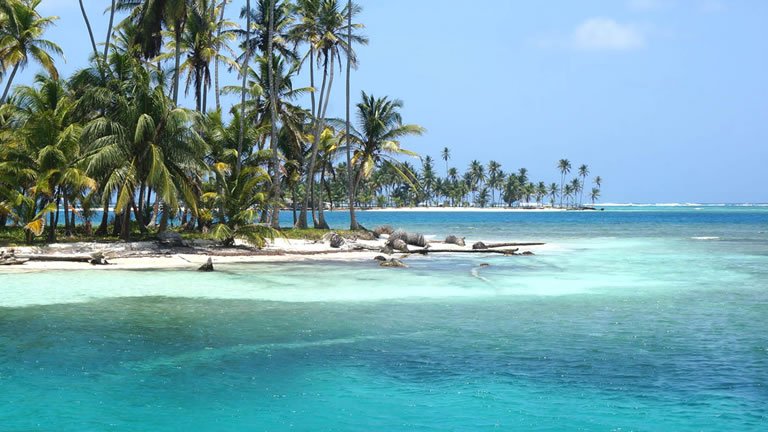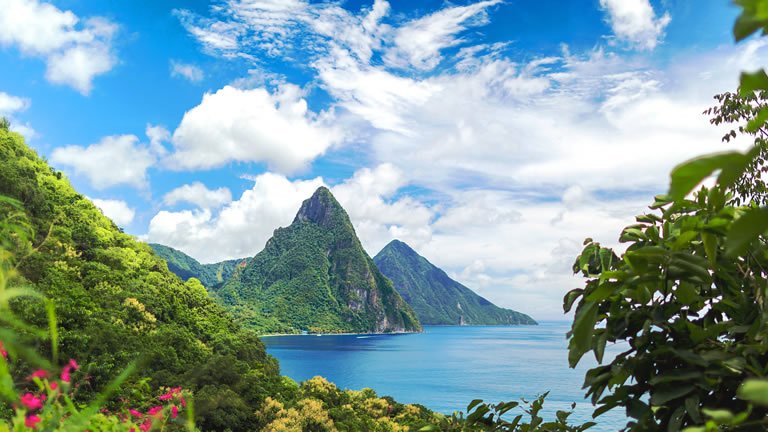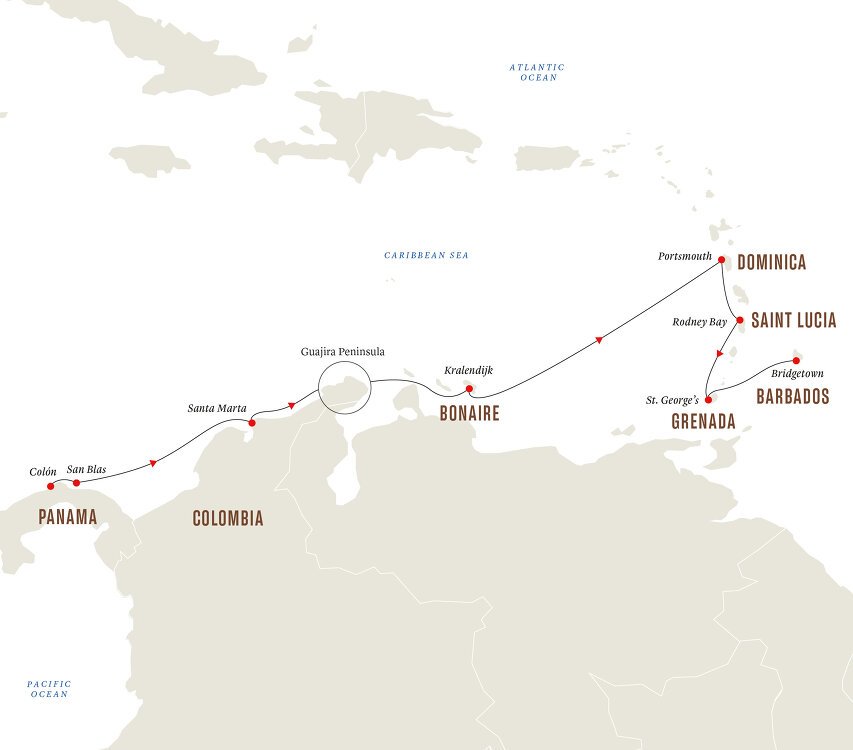From Panama To Barbados - Expedition Cruise To The Southern Caribbean
Overview
Itinerary
Your tropical expedition cruise starts here in the bustling port city of Colon. Situated at the Caribbean entrance to the Panama Canal, Colón is a popular stop for cruises going to the Caribbean. Attractions here include hot springs, a thriving handicraft scene and some great restaurants with local delicacies.
If you only have a few hours, pick out some souvenirs for friends and family from one of the colourful shops before you embark on your journey. With one of the largest duty-free zones in the world and a thriving arts and crafts scene, there’s plenty of buying opportunities here.
With numerous walking trails and picnic spots, Fort San Lorenzo makes for a good day trip. Located at the mouth of the Chagres River, the old Spanish fortress offers commanding views of the sea, and birdwatching opportunities in a beautiful setting.
If you want to explore more of Panama, opt for one of our Pre-Programmes. Spend three nights at a peaceful jungle lodge next to the Chagres River. During your stay, you’ll visit a rainforest centre and a farm involved in reforestation. You’ll also explore the jungle on a night boat safari, and lap up views of the area by cable car.
Alternatively, enjoy an overnight stay in Panama City and visit the UNESCO site of Casco Viejo. Stroll its rustic cobblestone streets and plazas, admiring the architecture of colonial churches, mansions and the Metropolitan Cathedral. Linger at a cafe and try some of the local speciality coffee and cocoa, before transferring to Colón.
Once on board MS Fram, you’ll pick up your complimentary expedition jacket, locate your cabin, explore the ship and attend a mandatory safety drill. After dinner and a welcome toast by the Captain, your exciting adventure will get underway.
Hidden on the Caribbean coast of Panama, the San Blas islands are one of the world’s best-preserved mangrove and coral ecosystems. They’re made up of hundreds of islands, islets and cays, of which the indigenous Guna people inhabit roughly 50. Granted political and economic autonomy, they live much as their ancestors did in small wooden dwellings, and their integration with nature has helped this region preserve its beauty and biodiversity.
Although their villages are barely sixty miles from the bustling financial district of Panama City and the neon lights of Colon, the Guna live at their own pace. Only accepting ecologically friendly tourism and shunning mass-market cruise ships, they have preserved their culture and ancestral traditions up to this day.
Our plan for the day is to land on one of the islands in the archipelago. Prepare for the peace and tranquillity of a genuine paradise: no hotels, no crowds, no roads and no noise pollution. Meet the Guna people and discover their matriarchal society. For generations, the Guna women have been the primary food distributors, property owners and decision-makers. Seeing them make their signature colourful scarves and fabrics is always a highlight.
For nature lovers and sun worshippers alike, the San Blas islands offer the best of best worlds. Savor the sight and sound of verdant palm groves reverberating with birdsong. Enjoy swimming or snorkelling in the crystal-clear water gently lapping the sandy beaches. or grab a local brew, find a hammock in the shade, and enjoy the scenery of this place that’s often called the ‘Pearl of the Caribbean.’
Get ready to explore one of South America’s oldest towns. Founded in 1525, Santa Marta was an ideal launchpad for Spain’s conquest of Colombia. Surrounded by beautiful beaches and picture-book hills and mountains, Santa Marta is undoubtedly one of the most attractive towns in the country. As you explore this former Spanish outpost, you’ll discover a place packed full of history, beauty and charm.
Stroll around the central Parque Bolivar with its impressive statue of libertador Simón Bolívar, the hero of Latin American independence. You’ll also find the 18th Century Cathedral Santa Marta and many well-preserved colonial and republican houses. Look for the 17th Century Quinta de San Pedro Alejandrino, where Bolívar spent his last days. Adjacent is Jardín Botánico, a beautiful botanical garden containing many colourful plants native to the region.
For a comprehensive overview of the history of Santa Marta and its surroundings, head for the fantastic Tayrona Gold Museum. Located in the old colonial-style Customs House, the museum contains magnificent golden artefacts and an impressive collection of Tayrona objects.
Southeast from Santa Marta is the Sierra Nevada mountain range, the highest coastal mountain range in the world. Rising sharply 18,942 feet above the Caribbean Sea, it contains several climatic zones, from tropical to glacial.
Your gateway to accessing the natural beauty surrounding Santa Marta is the Tayrona National Natural Park, the original homeland of the indigenous Tayrona people. The park features miles of golden sands on one side, lush rainforest on the other and the picturesque figure of Sierra Nevada towering in the background. Whether you’re seeking contemplation and rest or adventures of the thrill-seeking variety, you’ll be spoilt for choice in this magnificent piece of the Columbian coastline.
On the Guajira Peninsula, Punta Gallinas, literally ‘Chickens Point’, wins the trophy for being the northernmost tip of South America. In geographical terms, this is Colombia’s Cape Horn. Any other similarity with its southern partner ends here, however. The Guajira Peninsula is a slice of desert landscape amidst the tropical Caribbean coast.
The eerily spartan landscapes of the Guajira Peninsula are the homeland of the Wayúu people. Numbering close to 150,000, they represent half of the region’s population and have closely maintained their ancestral customs and values. Proud of their culture and independence, they never surrendered to the Spanish conquistadores.
More challenging to explore than the rest of the Caribbean shoreline, the coasts of the Guajira Peninsula are open to the Caribbean Sea and are exposed to wind swell. There are also only a few sheltered bays deep enough for even small ships to anchor safely. This means local conditions will rule the day and influence what activities we’ll do.
We’ll try to round the northern tip of South America, sailing past the lighthouse of Punta Gallinas. Weather permitting, we’ll attempt to anchor at Cabo de la Vela, Columbia’s windsurfing capital. Renowned for its spectacular landscape, it’s home to a captivating mix of rocky cliffs, arid plains dotted with cacti, and a calm, paradisaic beach. Nearby, the famous landmark of Pilón de Azucar offers sweeping views of the ocean and desert.
Today we’ll call at Kralendijk, the bright and colourful capital of Bonaire, a Dutch island located just north of Venezuela’s Caribbean coast. Bonaire and neighbouring Aruba and Curaçao have a long association with Dutch, Spanish and Portuguese settlers. The result is an exhilarating cultural mix with elements from the Old and New World.
Kralendijk is a sizeable yet charming village located midway along the island’s boomerang-shaped coast. Ideally sized to be explored on foot, the historical centre has one main street parallel with the sea. Getting lost is something you won’t have to worry about. Browse the craft markets on every street or head for the produce market near the pier.
It’s an easy walk to vibrant Fort Oranje, Bonaire’s oldest structure. Built by the Dutch in 1639, it has served several functions over the years, except for its intended purpose as a military fortification. Nearby, Bestuurskantoor will give many government offices a run for their many in their money in the looks department. Painted in an eye-popping yellow, this historic building is a fine example of Dutch Caribbean architecture.
Less than five minutes’ walk from Fort Oranje, Terramar Museum displays the best archaeological collection of the island, covering more than 7,000 years of Bonaire and Caribbean history. Well organised and informative, it’s a must-visit if you’re interested in Caribbean culture and history.
If you want to explore Bonaire further, join one of our optional excursions. Soak up the island’s natural beauty on a nature walk and see some historic landmarks. You can also scan for birds, including flamingos, at the many Ramsar sites across the island.
After five days of adventure, you’ll be grateful for the opportunity to recharge your batteries on your comfortable expedition ship. Start the day with some yoga or join the Expedition Team for lectures on topics varying from wildlife and geology to indigenous peoples and the general history of the Caribbean.
Sea days are also the perfect time to get up to speed with what’s happening in the Science Center. Our access to some of the world’s most remote areas enables us to provide the scientific community with precious data. We invite you to take part in these Citizen Science projects.
For example, as we sail, the Expedition Team might be taking Secchi disk samples of the water. These samples contain plankton, which is the basis of the oceanic food chain. Their distribution, abundance, and seasonality are sensitive to climate change. Our efforts help the scientific community keep abreast of these changes and their overall impact on the ocean. It’s this level of engagement that sets our expeditions apart from a traditional cruise.
Feel free to spend time out on the deck enjoying the fresh sea air as you scout for wildlife. After a sumptuous dinner, relax in the elegant Explorer Lounge or take advantage of the light pollution free skies to do some stargazing.
The Lesser Antilles island chain starts at the Virgin Islands and continues through the eastern Caribbean all the way down to Trinidad and Tobago. Our port of call for today is Dominica, sandwiched between the French islands of Guadeloupe and Martinique. If you’re looking for a mountain paradise by the sea, Dominica is the place - there are more mountains, volcanoes, and jungles here than anywhere else in the Lesser Antilles.
With two thirds of the island wild and densely forested, Dominica is green and luxuriant, covered by lush mountain rainforests. Volcanic activity has given birth to a dramatic, rugged landscape boasting a variety of volcanic wonders. Boiling Lake, the world’s second largest thermally active lake is here. So are Morne Diablotins, the second highest mountain in the Lesser Antilles, and Morne Trois Pitons National Park, a UNESCO World Heritage Site.
Portsmouth, our stop for the day, is ideally located to explore the natural wonders of Dominica. Closest to our landing site is the headland of La Pointe and the historical remains of 18th Century Fort Shirley, both part of Cabrits National Park. The tropical forest, swamps and sandy beaches of Cabrits National Park are an excellent place for nature walks and birdwatching.
See more of Dominica’s natural wonders on an optional excursion. You’ll learn about the traditions and customs of the locals. The island still has a community of indigenous Caribs, most of whom live on the eastern side. Dominica is nicknamed ‘Nature Island’, and by the time you head back to the ship, you’ll know why.
Before Christopher Columbus named it after Lucia of Syracuse, St. Lucia’s original inhabitants had given it a more descriptive name - Land of Iguanas. St. Lucia’s stunning volcanic landscape is a dream destination for many explorers. It’s blessed with lush rainforest, towering volcanoes, and many endemic plants and animals, including - as you’d expect - iguanas.
We aim to anchor in St. Lucia’s northern tip at Rodney Bay. The bay is named after Admiral George Brydges Rodney, who won the Battle of Saintes for England in 1782. Remains of Rodney’s fortifications can be seen at Pigeon Island National Landmark, situated within walking distance of our landing site.
Despite its name, Pigeon Island is a peninsula. It’s the perfect setting for a nature walk and will reward you with panoramic views of the ocean and the chance to learn about the island’s colonial past. When you’ve finished exploring, you can swim or sunbathe on either one of its two beaches.
If you choose to explore the village of Rodney Bay, you’ll discover one of the biggest marinas in the Caribbean and one of the region’s most popular yachting destinations. Built around a man-made lagoon, the marina has been beautifully landscaped. With many restaurants, bars, shops, and galleries, you’ll have plenty to do. Of course, no one will blame you if you simply opt to relax on the gorgeous beach!
To delve deeper into St. Lucia, join one of our optional excursions around the island. Only 27 miles in length, you can cover most of the highlights in a day. Much of the rainforest-covered mountains of the southern half of the island are within range for nature walks and birdwatching.
You’ll find there are numerous places in the world named after Granada, the Spanish city famed for the Moorish Alhambra palace. The lush volcanic island we’re visiting today bears no resemblance to its Iberian namesake, however. Dubbed ‘Spice Island’, Grenada is green and mountainous, densely forested and half-covered in nutmeg plantations. Circled by soft white sandy beaches, it’s the idyllic Caribbean paradise you’ve always dreamed of visiting.
We’ll call at St. George’s, Grenada’s vibrant and welcoming capital. The town is renowned for its attractive horseshoe-shaped harbour and its colourful pastel-painted Georgian buildings covered by red tiles. The Carenage is St. George’s lively waterfront walkway, winding around Grenada’s inner harbour. Wharf Road rims the Carenage with shops, restaurants, and offers great views of boats coming and going.
Most of St George’s architectural highlights are within walking distance of Wharf Road. Look for York House, the Georgian-style parliament building which Hurricane Ivan destroyed in 2004. The 19th Century Roman Catholic Cathedral, the Presbyterian church of St Andrew, and the Anglican Church of St George’s complete the trio of historic church buildings worth seeing.
Wander around the lively food market held daily in Market Square, selling everything from fruits to exotic spices. Continue to the National Museum, housed in a former army barrack. It features exhibits covering Grenada’s long history from the Caribs to the 2004 hurricane. Head to Fort George, built by the French in 1706 to protect the entrance to the Carenage. It’s the perfect vantage point for postcard views of the inner harbour.
To see more of Grenada, join one of our optional excursions. You’ll uncover the history of its plantations and learn about traditional agricultural life. Wildlife abounds in the central highlands. Densely covered by rainforest, it’s the perfect place for nature walks and birdwatching.
Your expedition comes to an end in Barbados, the easternmost island in the Caribbean. Fully independent since 1966, Barbados is a young, English-speaking country which a colourful history. Settled first by the Arawaks, then the Caribs, it was invaded by the Spanish, named by the Portuguese, and eventually colonised by British emigrants and West African slaves.
Our ship will dock at Bridgetown, the island’s capital, known affectionately by the locals as ‘Town’. With an attractive mix of old and new, Bridgetown’s historical centre is compact enough to be enjoyed on foot. It features outstanding examples of British colonial architecture from the 17th to the 19th centuries, and UNESCO-listed buildings worthy of exploration.
If you have time before flying home, explore Old Bridgetown. Stroll around the inner harbour of the Careenage and take in the UNESCO-listed Parliament Buildings, amongst the oldest in the English-speaking world. Head to the Garrison Historic Area, where more than 70 original buildings and forts from the 18th Century stand. If you want to sink your teeth into the island’s history, Barbados Museum is the place to go.
There’s more to Barbados than Bridgetown, however. The island is blessed with charming fishing ports, old plantation houses, historic distilleries, marvellous beaches, and deep caves filled with dramatic formations. Much more than can be seen in a day, so why not extend your stay with our Post-Programme.
Whether you choose to head straight home or linger a while, we look forward to welcoming you again soon.
Life Onboard MS Fram

Purpose built for a pure expedition experience and offering a comfortable base camp for remote exploration. Read more

Enjoy a fascinating onboard program and exciting excursions delivered by your dedicated Expedition Team. Read more
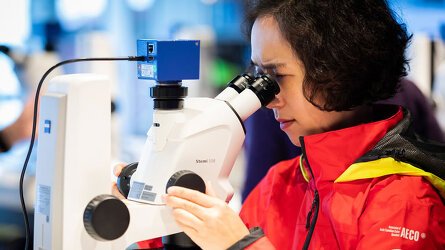
The home of edutainment and scientific learning on board, complete with lecture spaces and specialist equipment. Read more

Enjoy homely flavours in the informal main dining room and gourmet Nordic cuisine in the Scandi-chic specialty restaurant. Read more
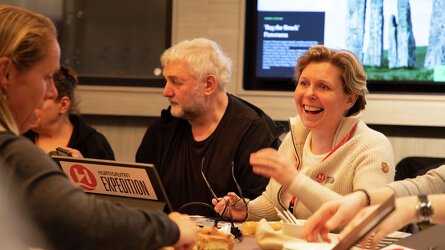
Experience a famously relaxed cruise complemented by a sense of cosiness, comfort, and contentment. Read more

Facilities include a gym, outdoor hot tubs, and a soothing sauna. Because even explorers need a comfortable base camp. Read more

Availability Click on prices below to view cabin upgrades and details
Tour & cruises prices are per person. Prices shown have savings applied, are subject to availability and may be withdrawn at any time without notice. Prices and trip information are correct at the time at this point in time, however are subject to confirmation at the time of booking and are subject to change by Hurtigruten. For cruise itineraries, cabin images are sourced from Hurtigruten. These should be treated as indicative only. Cabin inclusions, upholsteries and room layout may differ to the image(s) shown depending on the ship selected and your sailing dates.
Similar Cruises
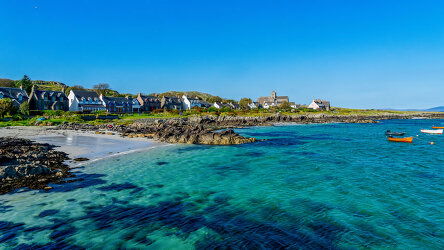
11 Days Glasgow Glasgow
Operated By: Hurtigruten
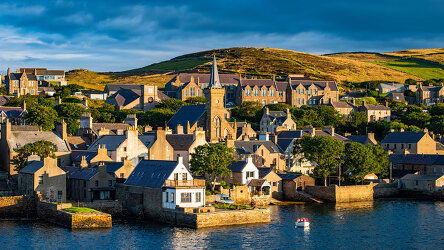
10 Days Edinburgh Reykjavik
Operated By: Hurtigruten

10 Days Oslo Oslo
Operated By: Hurtigruten
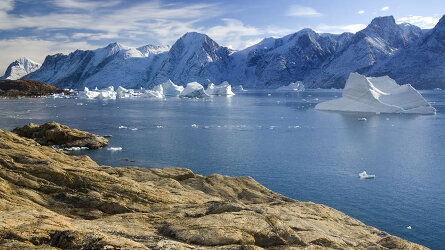
10 Days Reykjavik Reykjavik
Operated By: Hurtigruten
